This first table shows the AX280’s Watts/10 Delta Temp numbers in a quick glance chart format.

Using this data we can effectively show percentage gains/losses relative to a reference point. It’s an interesting way to show gains/losses while changing a variable.
So, let’s focus on 1300 RPM as our reference and see how much gain or loss in performance we get by changing fan speed.

From these results we see very large jump in performance of ~39% from 750rpm to 1300 in both Push Only and Push/Pull, however the the difference is much less with the next fan speed increase. This indicates that the core’s appears to be best tuned for medium to high speed fans.
So from the data above we’re getting a good idea of how the AX280 radiator performs relative to itself. But there is a large selection of 280mm radiator models to choose from, so let’s put the AX280’s results into some comparison charts.
Push Only Data vs Competition
Let’s focus on the Push Only results for now and come back to the Push/Pull data later.
NOTE: The performance results compare the AX280 against other 280mm radiators of varying thickness and core design, therefore it is likely to be outperformed by those radiators which are thicker and have denser cores. Furthermore, because the AX280 has a thin core in a medium thickness housing it positions itself rather awkwardly, not really qualifying as a slim radiator, but will likely have performance equal to one.
Let’s start with 750 RPM and see how the AX280 compares.
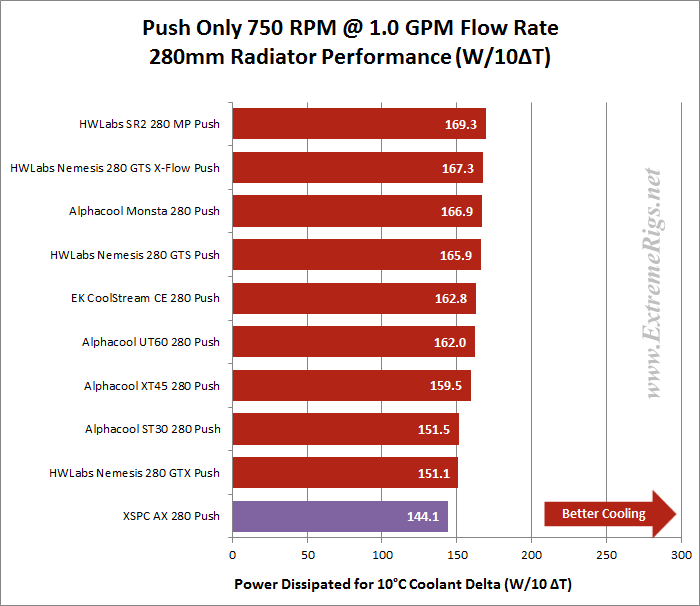
Clearly the AX280 is the worst performing of the radiators tested in Push Only at 750 RPM. With ~14% difference between it and the best performing slim radiator there there are clearly other options which perform better with this fan set up.
Now let’s look at 1300 rpm:
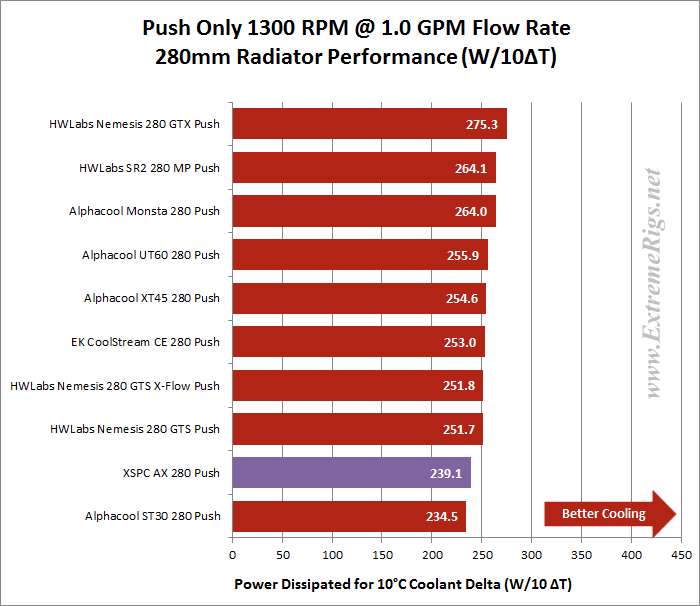
The pecking order settles down a bit at Push Only 1300 RPM with the bottom 4 rads all having thin cores and they have a maximum variance of ~7%. HWLabs dominate here with the two best slims and the two top overall.
Now 1850 rpm Push Only:
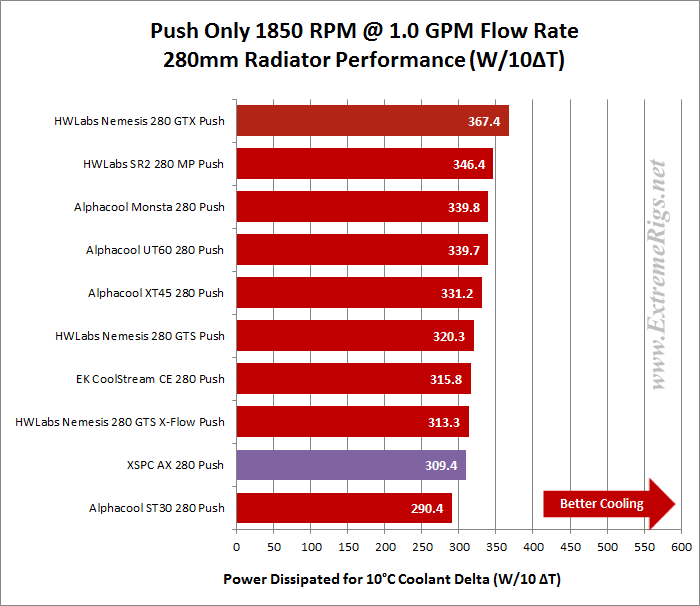 At 1850 rpm the AX280 gains ground on the other slims and is now only ~3% behind the leading slim radiator.
At 1850 rpm the AX280 gains ground on the other slims and is now only ~3% behind the leading slim radiator.
Let’s find out how the AX280 performs with Push/Pull fans.
Push/Pull Data vs. Competition
Firstly the 750 rpm:
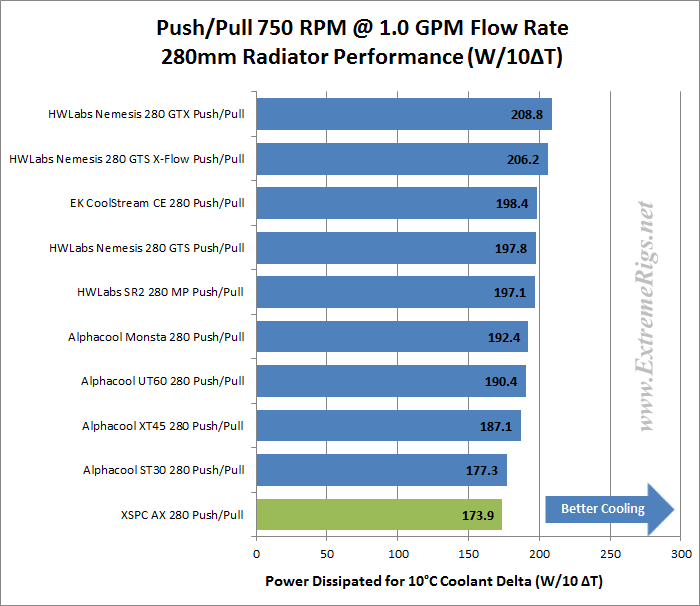 Again the AX280 lands in last position with a slow speed fan assembly. The 21 FPI is apparently just a bit too dense for low speed fans to dissipate the heat as well as the other radiators in the test group.
Again the AX280 lands in last position with a slow speed fan assembly. The 21 FPI is apparently just a bit too dense for low speed fans to dissipate the heat as well as the other radiators in the test group.
Let’s move to 1300 rpm:
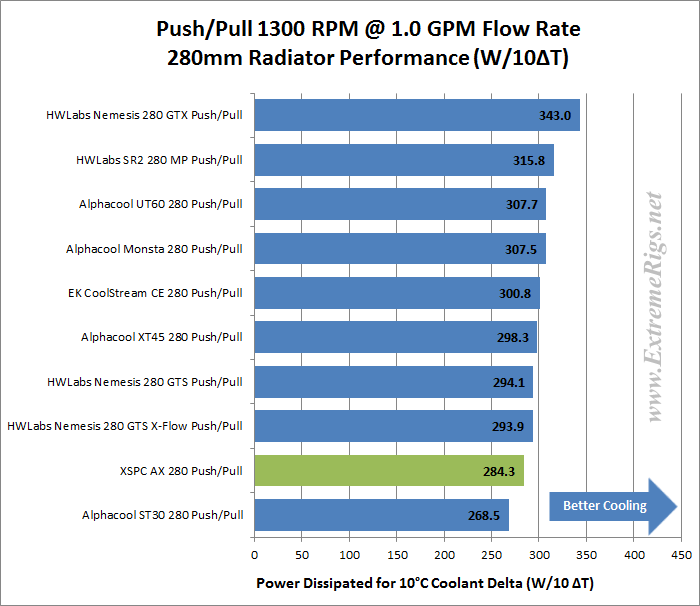
In the 1300 rpm Push/Pull places second last but is now only around 4.5% behind the best of the slims.
Now 1850 rpm:
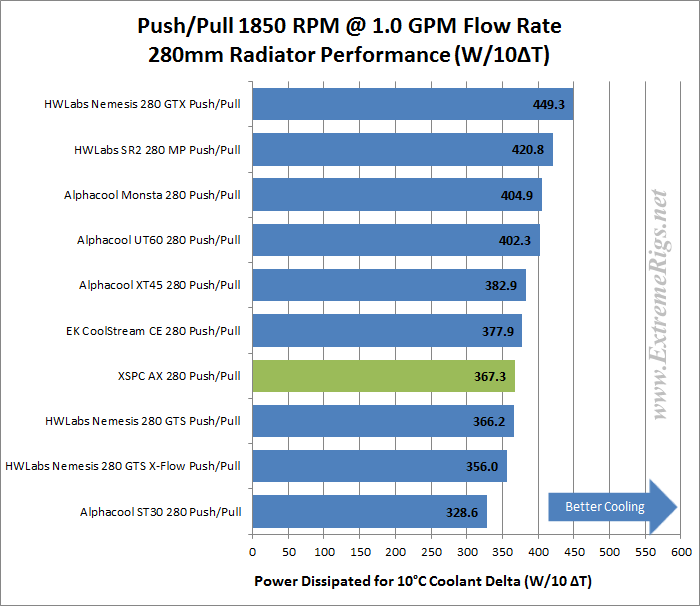 At 1850 rpm Push/Pull the AX280 places 6th ahead of the slims and not far behind the two x 45mm thick radiators of the group. I suppose we could almost call this a successful data point for the AX280. However I can’t help but note it is 25% thicker than the slim rads (which I have been “kindly” comparing it against) for a performance advantage of less than 0.5% over the best of the slims.
At 1850 rpm Push/Pull the AX280 places 6th ahead of the slims and not far behind the two x 45mm thick radiators of the group. I suppose we could almost call this a successful data point for the AX280. However I can’t help but note it is 25% thicker than the slim rads (which I have been “kindly” comparing it against) for a performance advantage of less than 0.5% over the best of the slims.
Let’s now combine the Push Only and Push/Pull results of our 1.0 GPM flow rate tests. Sometimes these combined plots show up some points of interest.
Again the 750 rpm first:
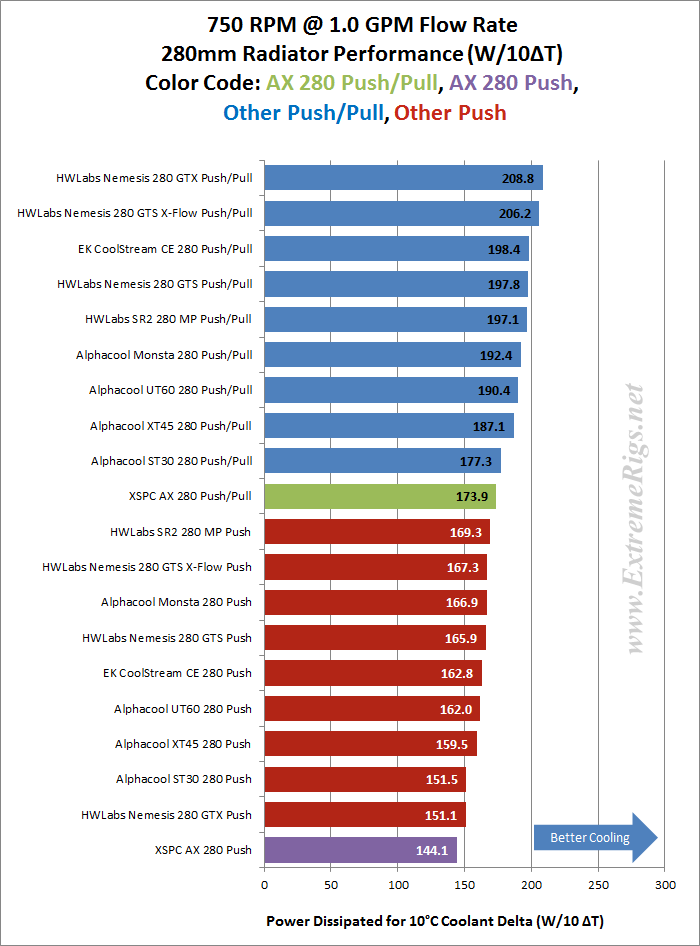 This plot is no so flattering for the AX280, but nothing looks out of place here given it is a repeat of the same data we just reviewed.
This plot is no so flattering for the AX280, but nothing looks out of place here given it is a repeat of the same data we just reviewed.
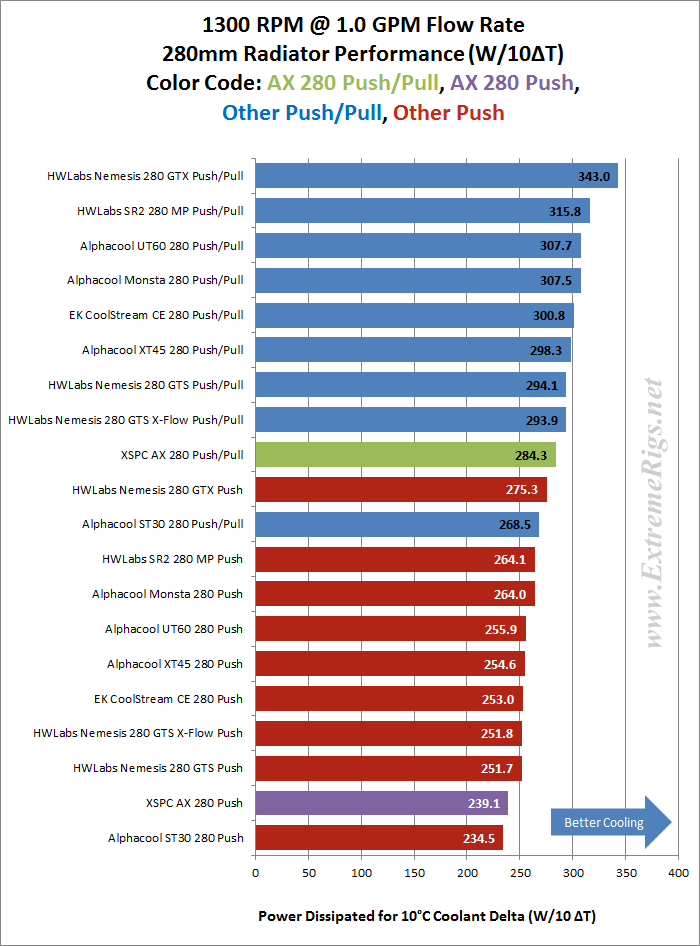
At 1300 rpm everything looks in order.
At 1850 the best Push Only result beat the AX280’s Push/Pull result, OK let’s call the result even with just 0.1 Watts difference. However the combined thickness of the Push Only radiator is 79mm while the AX280 Push/Pull thickness is 90mm. I’m certain our scoring system won’t pick up on that which is why these plots are sometimes interesting and we provide the data so our readers may further analyze for their own intended set-up.
Another view of the same data, this time plotted as curves and some extrapolation added.
Again the Push Only data first:
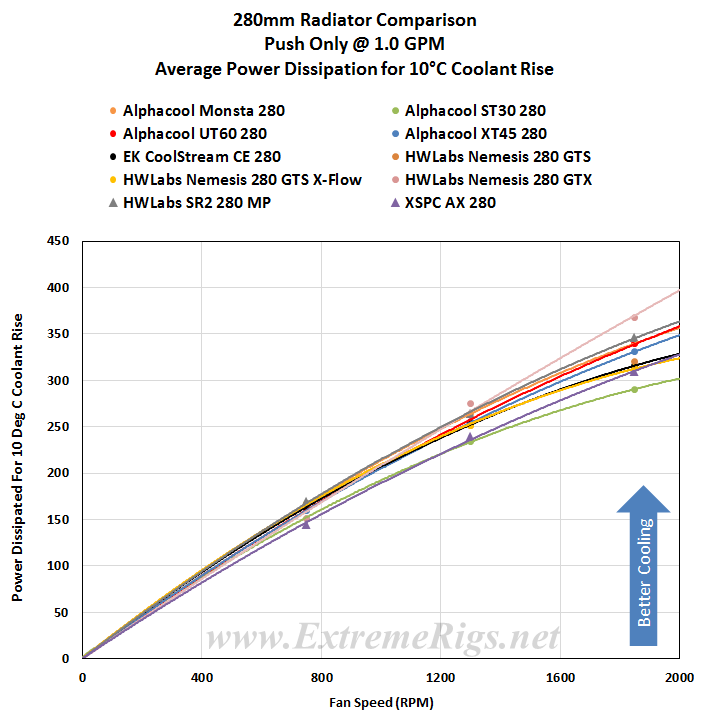 This perhaps best shows just how close the results are, particularly with low speed fans.
This perhaps best shows just how close the results are, particularly with low speed fans.
Because the data curves in plot above are almost blurred into one another, we have split it into two separate plots; 750 rpm to 1300 rpm and 1300 rpm to 1850rpm and zoomed in on those fan speed zones.
Now the Push/Pull results are plotted, again followed by split and zoomed versions.
From all the test results we created “Average Performance Factor” charts for both Push and Push/Pull. We then made a combined plot of the average called the “Master Performance Factor”. The radiator with the best cooling ability (W/10ΔT) at each rpm was awarded a score of 100. Each other radiators W/10ΔT result was scored as percentage of the top performer.
This way of looking at the comparison takes away any advantages that a radiator may have at higher or lower fan speeds and looks at an overall average. While this appears fair it does tend to favor those radiators that are all-rounders and those radiators which do very well at high RPM. Most users should be more focused on their specific use case.
Here are the AX280’s percentage scores at each data point:
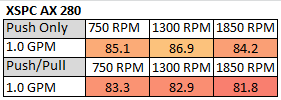 This table shows us that the AX280 is on average ~16% behind the best performing radiator at each data point that was tested.
This table shows us that the AX280 is on average ~16% behind the best performing radiator at each data point that was tested.
As these percentage scores are relative to the best performer at each data point, we again advise readers to cross reference specifications and results for each radiator and keep in mind your intended fan assembly and operating speed.
The percentage numbers in the table above offer another way of looking at the AX280’s results. But for our scoring system we need a way to reduce the categories while retaining the data. To do this we average the results for each fan assembly type giving us Averaged Performance Factors. We calculate this for Push Only, Push/Pull and finally an average of everything.
Firstly – the Push Only APF:
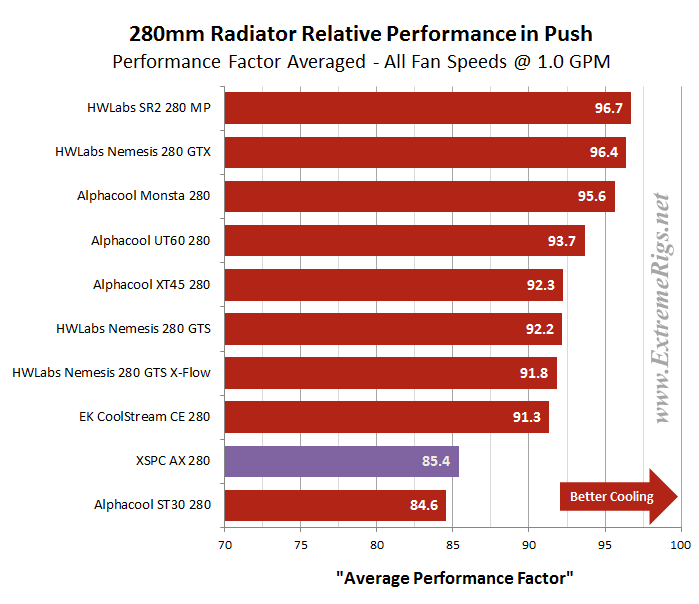 With an 85.4 % Averaged Push Only result the AX280 places 2nd last. Hardly an excellent result but it did at least beat one other radiator. It was however ~7% behind the best of the slims.
With an 85.4 % Averaged Push Only result the AX280 places 2nd last. Hardly an excellent result but it did at least beat one other radiator. It was however ~7% behind the best of the slims.
Now the Push/Pull APF:
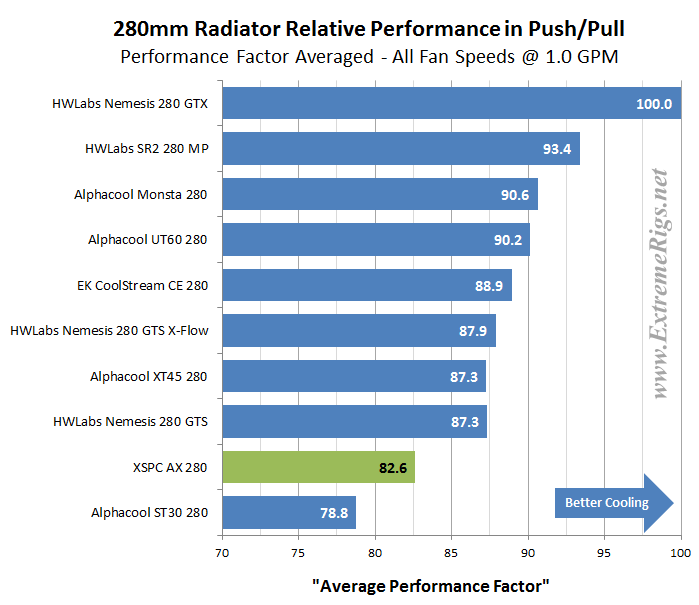 In the Push/Pull APF the AX280 again takes second last place, and is again ~7% behind the best performing slim radiator.
In the Push/Pull APF the AX280 again takes second last place, and is again ~7% behind the best performing slim radiator.
Finally we created the Master Performance Factor which is calculated from the averaged results of all the Push Only and Push/Pull thermal tests, at all fan speeds.
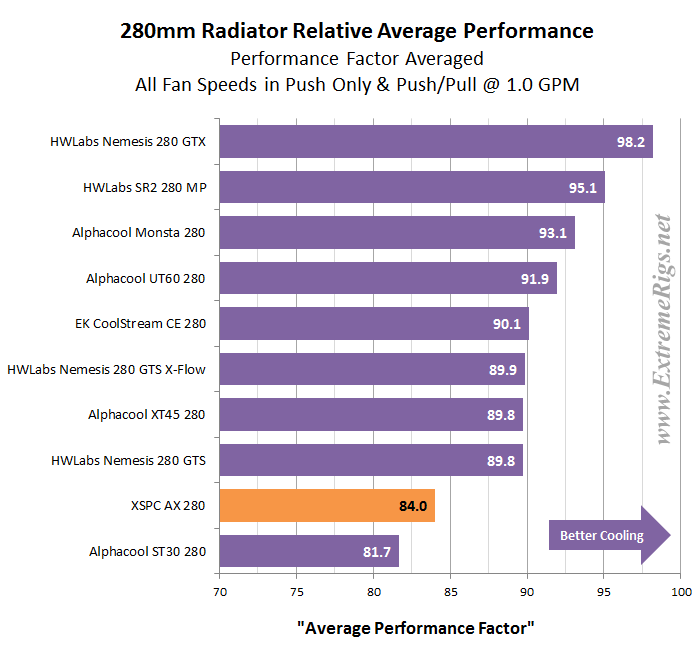 This results here should come as no surprise by now. Overall the AX280 finished in 9th place out of the 10 280mm radiators we tested.
This results here should come as no surprise by now. Overall the AX280 finished in 9th place out of the 10 280mm radiators we tested.
Space Efficiency
The AX280’s space efficiency vs. performance should be a breath of fresh air as thinner rads almost always produce better results here than their thicker counterparts. We have used the Average Performance Factor results from the charts above to compile two plots which shows us how it compares to the other rads in terms of performance Vs. space taken.
Firstly is radiator thickness Vs. APF
Here the combined APF scores were divided by the radiator thickness only, with the highest (most space efficient) issued a score of 100. Each of the other radiators results was converted to a percentage of the most space efficient radiator’s score.
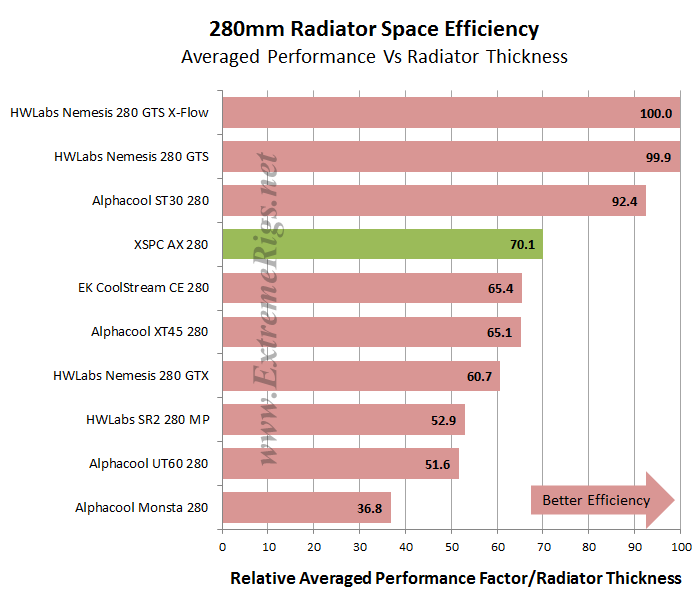
The results ended almost in order of thinnest to thickest.
Next we took the APF results for Push/Pull and divided it by the total thickness including the fans and applied the same scoring system. For the Push Only we used the Push Only Vs Push/Pull comparative results and applied the same scoring system when compared against the Push/Pull.
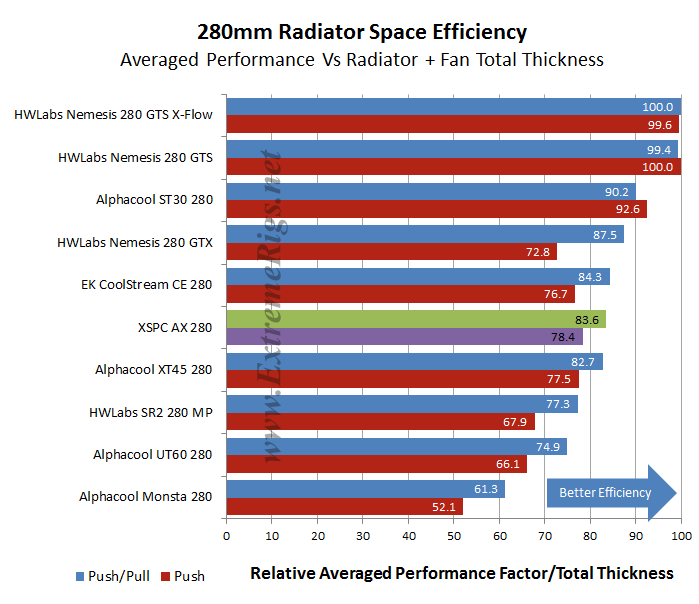 This plot is likely the most useful for readers of the 2 plots for space efficiency. With fan thickness factored in the AX280 finishes middle of the pack.
This plot is likely the most useful for readers of the 2 plots for space efficiency. With fan thickness factored in the AX280 finishes middle of the pack.
Value Factor
While our APF’s are still fresh in mind, let’s now look at some performance results vs Price to show which of the 280mm radiators might offer the best bang for your buck. Each radiator’s combined APF scores were divided by the radiator cost and again we applied our scoring system of percentage Vs. the best performer of the category.
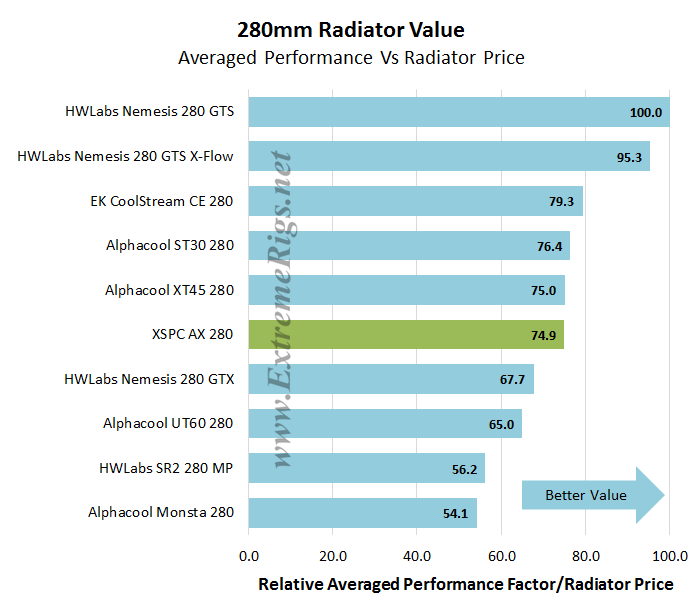 The AX280’s Value Factor turns out to be quite average, which tells us that it is neither terrible nor exceptional value for the performance potential it offers. In reality the difference is not great, but when visualizing with percentages as we have done, the gap appears large.
The AX280’s Value Factor turns out to be quite average, which tells us that it is neither terrible nor exceptional value for the performance potential it offers. In reality the difference is not great, but when visualizing with percentages as we have done, the gap appears large.
Next Up – Summary!







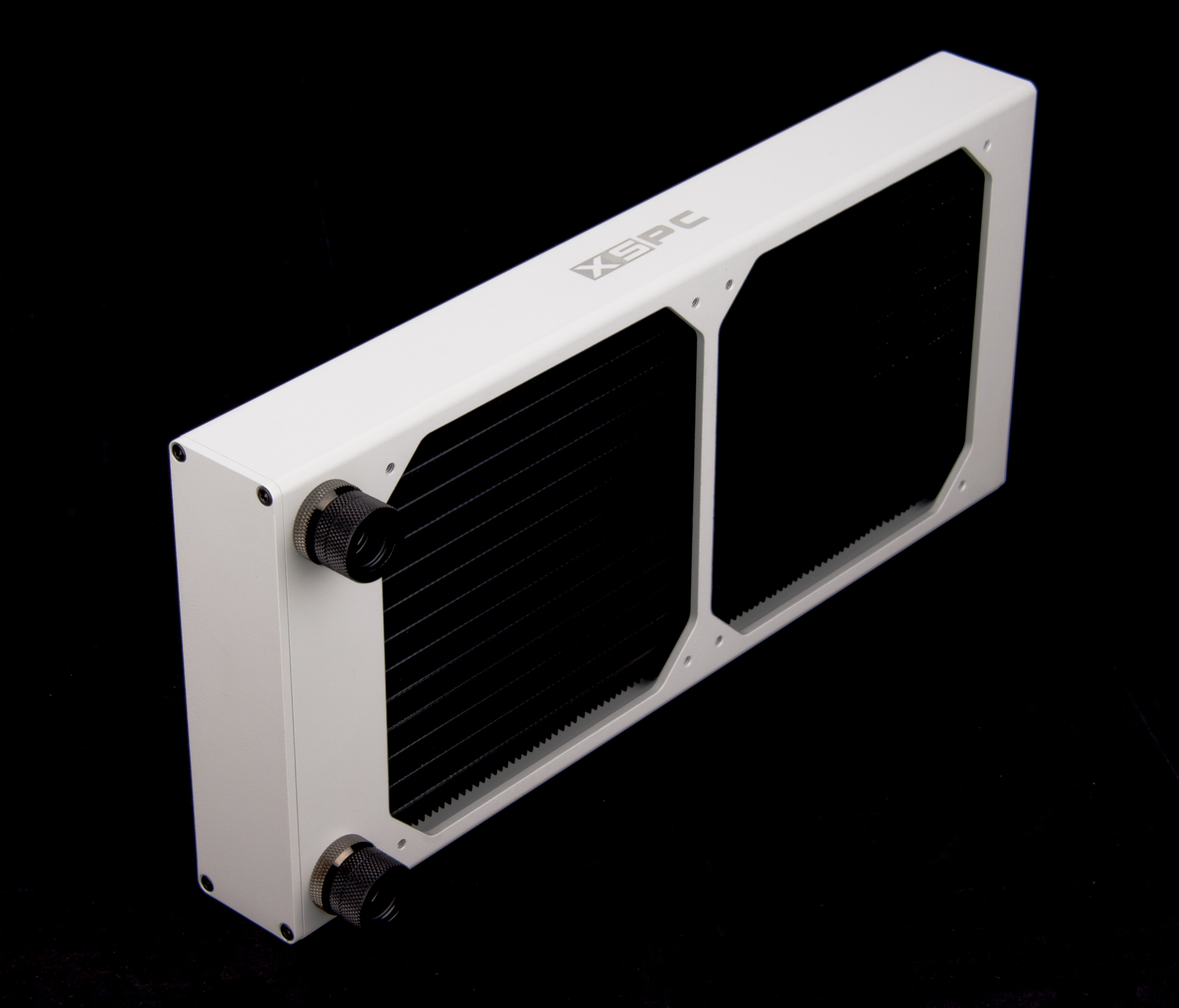
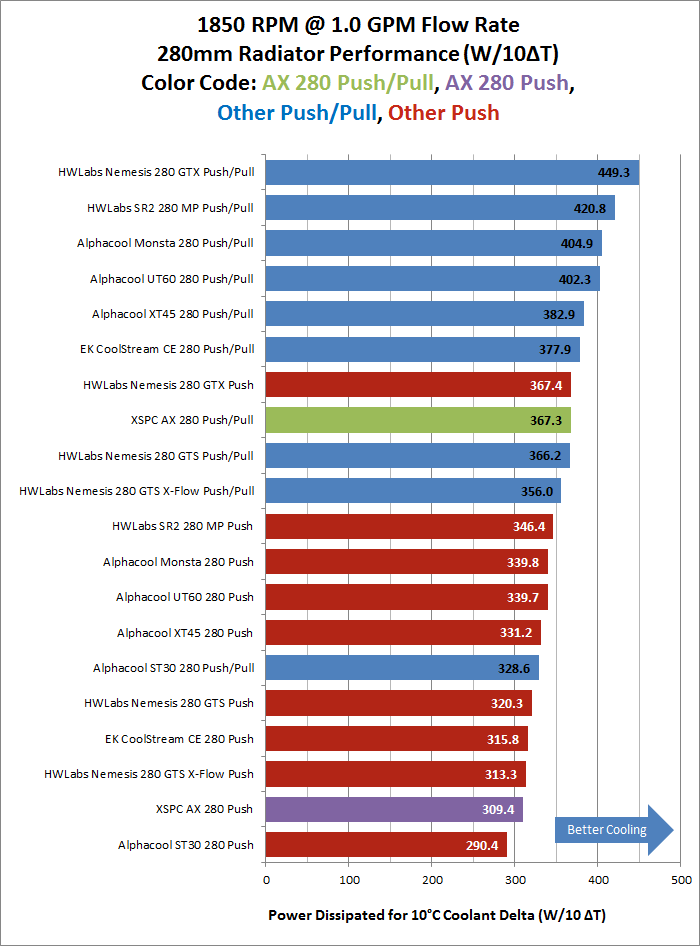
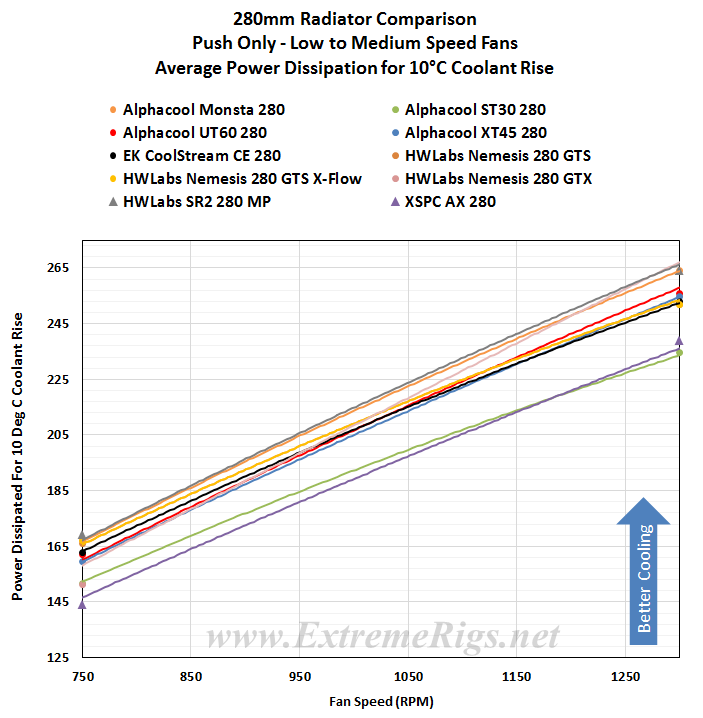
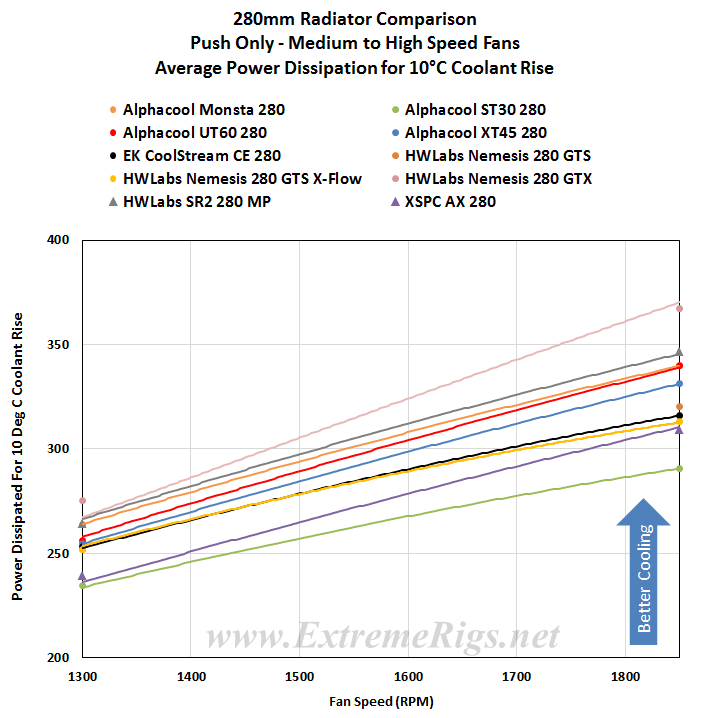
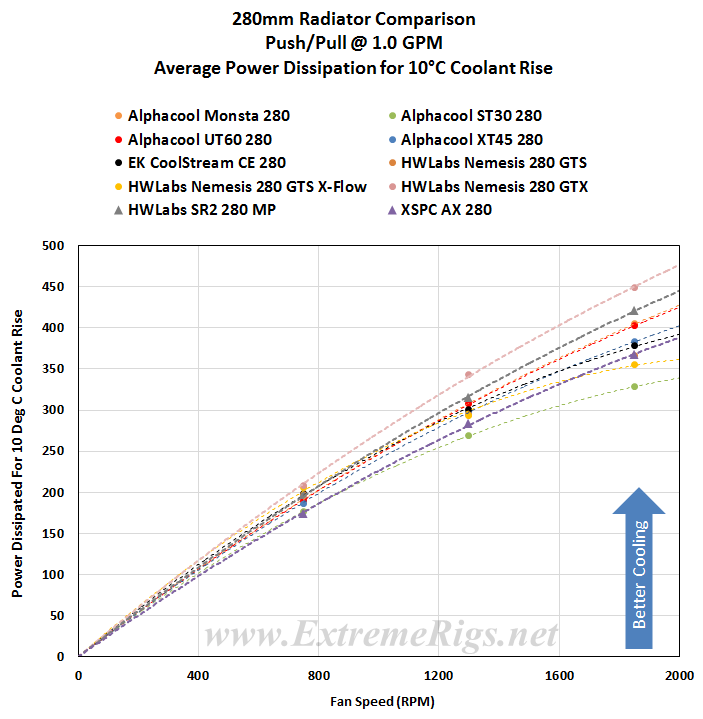
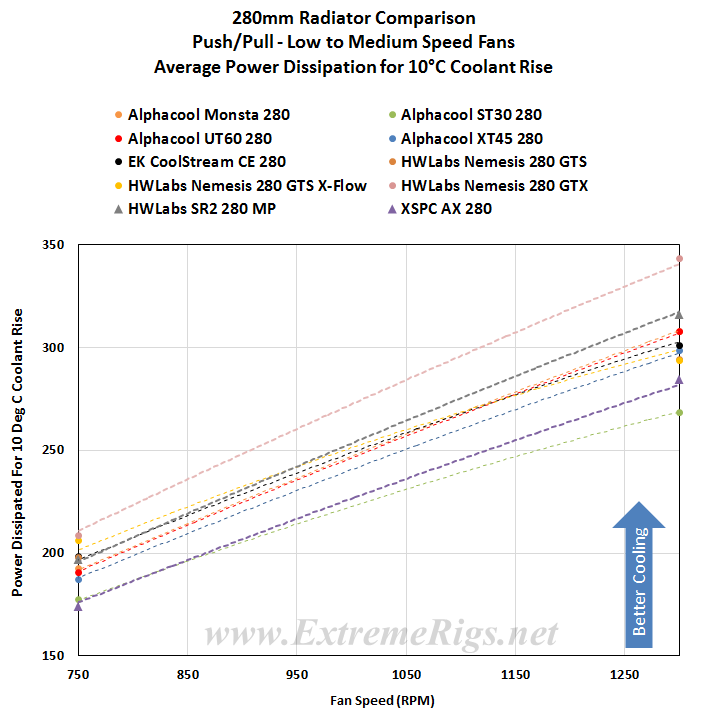
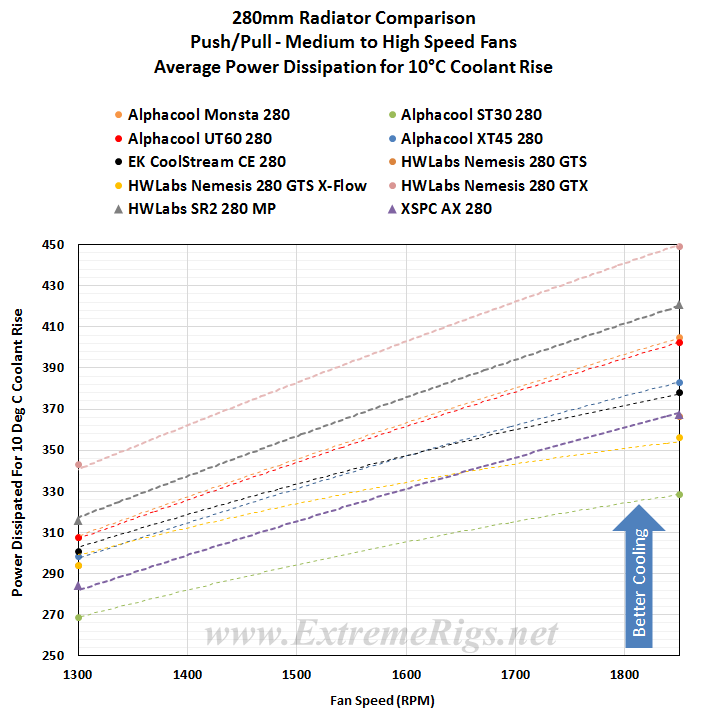



very grateful for the work you continue doing, can’t wait for the rest of the 280mm radiator review to pop up.
cheers
Thanks a ton for including all the data from your 280mm tests. I am just about to purchase a 280 radiator and have been going back and forth between the 280GTS, 280GTS X-Flow, and CE280…except using 140 and 360 tests as a basis for my decision. The data shown here has helped me tremendously. Thanks!
Glad to have been on assistance.
We included a few extra plots this time and it’s probably getting close to data saturation point for many readers.
Let us know which plots are the most and least useful to you guys.
We can try to streamline a little if the vast majority prefer less plots.
We don’t really like to use spoilers, as we consider the data either useful or not.
Really appreciate all the work you and Stren put in. I personally think the radiator efficiency space/radiator relative average performance graphs arent needed (but appreciated). People reading these reviews Im sure are capable of figuring this stuff out on their own based on the thermal tests you provide and just a little extra homework. 🙂
Hey fast_fate, you guys have become my go-to site for water cooling information. I wish I had found your site a couple of years back when I first started on this WC obsession, you would have saved me some ca$h! And while I realize the AX280 is the focus of this review, you have also made me very happy in showing just what a beast the Hardware Labs Nemesis 280GTX radiator is. I just picked this up a few months back in all-white form from Performance-PCs and am very happy to see that not only is it a class leading 280mm radiator, it actually outstrips the (non opti-flow setup) Nemesis 360GTX! And the best part is that it fits more cases than a 360mm radiator due to it’s reduced height.
Great review on the AX280. I very much like the AX series rads, and their case/shroud construction feels more robust and bomb-proof than the EK versions. But the one thing I do like about the CE and XE versions from EK is that they are “non-louvered” fins which means they will be less likely to become polluted by environmental dust. The AX series, much like the EX series being higher FPI and louvered would be a bit more sensitive to dust accumulation.
Great job and thanks!
Comments are closed.